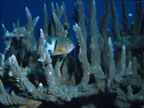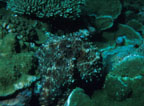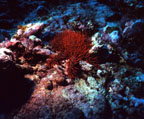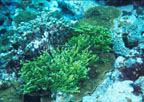|
|
Error processing SSI file |
Click on any image for an enlarged view
|
|
The Living Sanctuary
|
This large sea star is known locally as a lima. It is found on reef flats and is a striking bright blue. Not common in Fagatele Bay, the sea star is common on other reef flats of American Samoa. As a member of the phylum Echinodermata, the sea star's body plan is radially symmetrical, that is, equal units arranged in a circle around a central disc. (photo: Kip Evans) |
|
|
These are little jawfish that live in sand flats. They share their holes with a small shrimp (photo: Kip Evans) |
|
|
This clownfish and sea anemone live together in a symbiotic (mutually beneficial) relationship. The clownfish cleans the anemone of algae, and the anemone protects the fish from predators with its nematocysts (stinging cells), to which the anemone is immune. (photo: Kip Evans) |
|
|
This coral exhibits a contorted laminar, or tier form, and is found in large patches in Fagatele Bay. The large surface area created by the convoluted shape offers many niches for other marine life. (photo: Kip Evans) |
|
|
Some fish and corals have symbiotic relationships, such as this damsel fish swimming within branching stony coral. The coral branches provide the fish protection from predators, and the fish excretes nitrogen in the form of ammonia, which the coral uses for growth. (photo: Kip Evans) |
|
|
As a member of the class Cephalopoda, the octopus changes color for camoflage against visual predators. The octopus produces these color changes through special pigment-containing cells called chromatophores. (photo: Kip Evans) |
|
|
Generally a solitary dweller, the octopus often seeks shelter or a permanent den in a cave or under rocks. The octopus does not normally swim about in the water unless threatened. (photo: Kip Evans) |
|
|
Within the class Holothuroidea, some tropical sea cucumbers possess toxic substances in their skin. This particular variety is edible and is commonly called beche de mer. (photo: Kip Evans) |
|
|
The crown-of-thorns sea star Acanthaster planci, is a corallivorous (coral eating) echinoderm that ravaged the reefs of Tutuila in the late 1970s. Many sea stars consume their prey by extruding their stomachs, digesting the organism's soft tissues, then sucking in the digested material. (photo: Kip Evans) |
|
|
A member of the family Decapoda (10 legs), there are approximately 4,500 species of true crabs found in a variety of marine, estuarine, and terrestrial habitats world wide. This crab was observed crawling on a boulder on the beach in Fagatele Bay. (photo: Nancy Daschbach) |
|
|
Giant clams, Tridacna sp., are a favored food item for Samoans and, consequently, are relatively rare on reefs in populated areas. (photo: Nancy Daschbach) |
|
|
Multicellular or macroalgae are limited to areas of shallow water and rocky shores; the algae need light for photosynthesis, and a solid substrate for attachment sites. Wave action, dessication during low tide, and grazing by herbivores are all potential threats to these plants. (photo: Kip Evans) |
|
|
The genus Pocillipora is one of the most common types of coral found in American Samoa, and has some of the most widely distributed species throughout the Pacific. The species pictured here, consists of compact clumps composed of uniform, thick, primarily upright branches with flattened ends. (photo: Kip Evans) |
|
|
Coral diversity involves a range of growth patterns as well as species types. This coral exhibits a laminar, or tier forming growth pattern, with wide flat layers of coralline growth developing above each other. Other growth patterns include branching, columnar, and encrusting. (photo: Kip Evans) |
|
|
The genus Pocillipora has many regional endemic species. These have probably evolved due to "rafting." This is where small colonies of coral make long journeys attached to floating objects and become established in remote places, isolated from the original population. (photo: Kip Evans) |
|
|
On densly populated Indo-Pacific reefs, many coral species coexist through a complex series of inter-, and intraspecific competitive interactions, establishing a hierarchical dominance amongst themselves. Here species of Pocillipora, and Porites coral grow in close proximity. (photo: Kip Evans) |
|
|
Belonging to the phylum Porifera, or "pore bearer", sponges are considered to be among the simplest living organisms. All sponges are filter feeders, collecting small particles of food from the sea water flowing through their bodies. (photo: Kip Evans) |

















